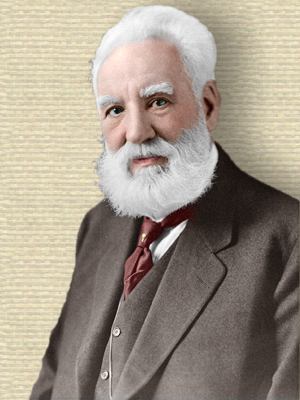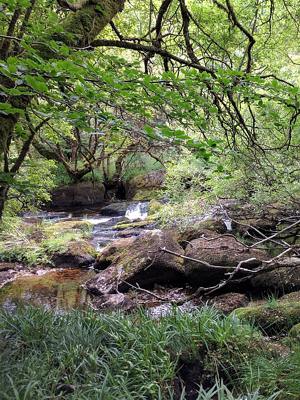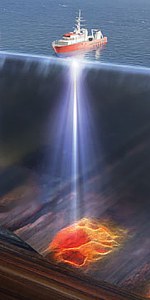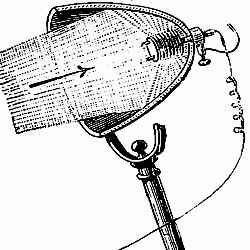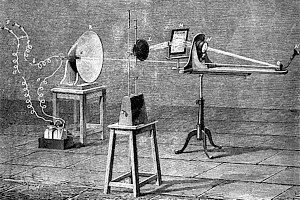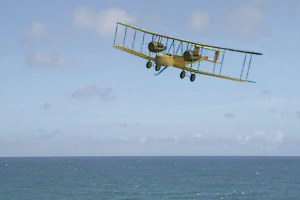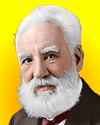 (source)
(source)
|
Alexander Graham Bell
(3 Mar 1847 - 2 Aug 1922)
Scottish-American inventor of the telephone (patented 7 Mar 1876), and cofounder of the Bell Telephone Company (1877).
|
DISCOVERY AND INVENTION
By Alexander Graham Bell
An address to the graduating class of the Friends’ School, Washington, D. C, delivered May 22, 1914.
[p.649] I am going to begin tonight by asking you a rather startling question: Did you ever put your head under water and chuck two stones together to see what the sound is like? If you have never done that, try it, and you’ll get a new sensation. I did it once, and it sounded as if a man were hammering for all he was worth at my very ear.
I then took two tiny little pebbles and tapped them together quite lightly under water, and it sounded like a man knocking at the door. It was rather startling to hear such a loud noise from such a slight cause.
Of course, the question at once arose in the mind: How far off could we hear the sound? So I sent a boy a hundred feet up the beach with a couple of stones, directing him to strike them together under water. I then submerged my head, and I could hear the sound about as readily as before.
Well, I determined to test the maximum possible distance, and sent the boy across the bay in a boat to the other side, to a point at least a mile away from the place where I stood, and I followed him with field glasses to see that he carried out my instructions. I saw him land on the other side, take off his coat, roll up his sleeves, and go down to a little plank wharf on the shore rising only a few inches out of water. He lay down upon the wharf, face downward, and put his hands into the water, and I then knew he was making signals with these stones.
Now, the question was: Could I hear him? Quietly and gently I went into the water at my side of the bay, submerged my head, and listened for all I was worth. Well, you know, the signals came perfectly clear and distinct, through more than a mile of water, to my ear. It was one of the most astonishing revelations of what could be done with water.
You know if you look away in the distance at a man firing a gun you can see the flash, and after a time you get the report; the sound takes time to travel through the air. It goes about 1,100 feet per second; but in the water it goes five times as fast as that—over 5,000 feet per second. Water is a much better conductor of sound than air.
DO FISH SIGNAL TO ONE ANOTHER BY SOUNDS?
Reflecting upon these various experiments, the thought occurred: If two little stones tapped together can be heard under water, why, every tiny lobster that snaps his claws must make an audible click. I wonder if there are creatures in the water that signal to one another by sound.
Well, I had occasion to try it once. Bathing in the Grand River in Ontario a great many years ago, I put my head very gently under water and listened, and, sure enough, “tick, tick,” came a sound like a grasshopper’s chirrup, and a little while after that a chirrup on the other side. There were creatures under the water that were calling to one another.
I don’t know whether all fish make sounds or not, but there are some fish that certainly do. The drumfish on our coast drums away in the water so loudly that you can hear him while you are walking on the shore.
It is also a significant fact that all fish have ears. Why should they have ears if there is nothing for them to hear?
Of this we may be certain—that there is a whole world of sound beneath the waves waiting to be explored, perhaps by some of you.
I have wanted you to see how one observation leads to another. Starting with a very small thing—the chucking together of two pebbles under water, and following this up by other observations—we broaden our field of knowledge and reach generalizations of considerable magnitude as the resultant of numerous small thoughts brought together in the mind and carefully considered.
OUT OF THE BEATEN TRACK
[p.650] I was walking along the road one day in my country place in Nova Scotia, when the idea occurred to leave the beaten track and dive into the woods. Well, I had not gone 50 feet before I came upon a gully, and down at the bottom was a beautiful little stream. I never knew of it before.
Of course, I was not satisfied with the mere discovery, but went down into the gully and explored it right and left. I followed it up to its source. I followed it downward for half a mile, through a beautiful moss-grown valley, until at last the little streamlet discharged into a pond, and away in the distance I could see a sea beach with the open water beyond.
Now, just think of that! Here was a beautiful gorge, half a mile long, right on my own place, and coming at one point within 50 feet of a well-trodden road, and I never knew of its existence before. We are all too much inclined, I think, to walk through life with our eyes shut. There are things all round us and right at our very feet that we have never seen, because we have never really looked.
Don’t keep forever on the public road, going only where others have gone and following one after the other like a flock of sheep. Leave the beaten track occasionally and dive into the woods. Every time you do so you will be certain to find something that you have never seen before. Of course it will be a little thing, but do not ignore it. Follow it up, explore all round it; one discovery will lead to another, and before you know it you will have something worth thinking about to occupy your mind. All really big discoveries are the results of thought.
THE BEGINNINGS OF INVENTION
I dare say you have all heard of that celebrated painter who would never allow any one to mix his colors for him. He always insisted on doing that himself, and at last one of his students, whose curiosity had been aroused, said: “Professor, what do you mix your colors with?” “With brains, sir,” said the professor. Now, that is what we have to do with our observations.
I think I left you with your head under water listening to the clicking of two stones. Now, let us see whether we cannot use our brains to get you out of so awkward a predicament. We will then have entered the realm of invention, as distinct from discovery.
Why should we not simply put the ear to the water instead of submerging the whole head?
Why should we not ring a bell under water instead of clicking stones together to make a noise. An ordinary dinner bell would do. Empty it of air and ring it under water, and the sound can be heard by a submerged ear at a great distance away.
It is a little awkward, however, to keep the ear continuously submerged on account of the movements of the surface water. Every now and then a little wave will slap you in the face, and you are apt to choke if you are caught unprepared.
Why would it not be better to transmit the sound vibrations from the water to the ear through some intervening mechanism, and thus obviate the necessity of submerging the ear at all?
I have tried submerged hearing tubes of various kinds and planks of wood partially submerged, with the ear applied to the part out of water.
If you put your ear to the bottom of a boat—inside, of course, not outside—you can hear a bell at a distance quite readily. It still is a little awkward, however, to get your ear against the planks of the boat; but brains will help you out. Just fix a telephone transmitter to the planks of the boat, and you can sit at ease with the telephone receiver at your ear.
You may even put the telephone transmitter overboard. It then becomes a submerged ear and will listen for you under water.
FISHING WITH TELEPHONES
I have often thought I should like to go on the banks of Newfoundland and fish with a telephone. If you were to send the transmitter down among the codfish with the bait, perhaps you would find something there to hear. I have never tried it. I will leave that to you.
We now have numbers of steamers [p.651] upon the Atlantic fitted with telephone transmitters attached to the thin iron skin of the hull, away down in the hold, and the receiving telephone on the bridge.
On shore there are huge bells at lighthouse stations making fog-signals under water, and each steamer as it approaches the coast can pick up these submarine sounds at a distance of 10 miles.
Here is a completed invention which some patient observer has evolved from just such little beginnings as those I have described.
I doubt whether you could hear a fog-signal through the air at any such distance as that. The air is at best but a poor conductor of sound, and many illusions of hearing are possible.
It is difficult in any case to tell the exact direction of a sound in a fog. It is possible, too, that you might have an echo from the sails of a vessel, and you would then be entirely misled as to the direction of the signal station.
Then, again, an island anywhere near casts a sound-shadow upon the water. The sound-wave striking the island is deflected up into the sky, and you would have to go up in a balloon to hear it, and it may not come down again to the surface for a mile or two beyond the island. A ship quite close to the island might not hear the sound. The captain, knowing that the fog-horn should be heard at least a mile or two away, imagines himself to be much farther off than he really is, and in the midst of the fog he may become conscious of the presence of the land only by actual contact with it.
Then the transmitting qualities of the air are subject to variations on account of unusual atmospheric conditions. You may be quite near a fog-signal station and yet hear the sound so faintly that you imagine it to be far away. You may even get an echo from the clouds; but then you know you are subject to an illusion, for the sound seems to come from the sky.
Now, sounds can be transmitted through the water to far greater distances than through the air, and atmospheric conditions have no effect.
I don’t want to confine your attention to inventions that already have been made. I want to show you also that there is room for something new. We don’t know everything yet and the list of possible inventions is not yet closed. Take, for example, the case we have been talking about, the transmission of sound through water.
EXPLORING UNDER THE SEA
Three-quarters of the earth’s surface is under water and has not yet been explored, at least to any great degree. The only way we have of reaching the mountains and valleys at the bottom of the sea is by sending down a sounding line and bringing up a specimen of the bottom attached to the sinker. It is no joke, however, to reach the bottom of the deep, blue sea through one mile or even two miles of water, and it takes several hours to make a single sounding. Just think of all the time and labor involved in merely ascertaining the depth.
Why should we not send down a sound instead and listen for an echo from the bottom. Knowing the velocity of sound in water and the time taken for the echo to reach the ear, we should be able to ascertain the depth of the deepest part of the ocean in less than four seconds instead of more than four hours. Here is something worth doing. It has never been tried. I have suggested it a number of times, and I will now pass on the thought to you in the hope that some of you may care to take it up.
Suppose you are on one of those steamers provided with transmitter hulls and telephone ear-pieces, and you send down a little piece of gun-cotton or other explosive material to a safe distance below your ship and then explode it by an electrical contact. The sound-wave from the explosion will, of course, go down to the bottom and then be reflected up again, so that after a certain length of time you should get an echo from the bottom.
Not only should you be able to tell the depth of the ocean by an echo from the bottom, but you might perhaps learn something of the nature of the bottom itself. A flat bottom should yield a single sharp return, whereas an undulating bottom should yield a multiple echo, like that heard when you fire a pistol among hills.
[p.652] Then, as you approach the shore you should get resonance effects, like those perceived when you shout out loudly in an empty cave.
However, I must not take up your time in speaking upon only one subject. What I want to direct your attention to is that both discovery and invention are not things that come all at once. They arise from very simple beginnings. A small observation, patiently followed up by other observations equally small, leads gradually to a big conclusion. Do not ignore little things; life itself is made up of them, and there is a good old Scotch saying that bears upon the point:
“Mony a mickle maks a muckle.”
A great many small things make a big one. Any one, if he will only observe, can find some little thing he does not understand as a starter for an investigation.
AN EXPERIMENT AT HOME
I had rather a curious illustration of this the other day in my own house. I told a lad who was waiting upon me that I wanted to make some experiments with a bottle of water, and told him to bring a bottle of very hot water from the kitchen, and be sure that it was quite full. He soon returned with a big-bodied bottle provided with a long and narrow neck, filled to the brim, and put it on the mantelpiece and went downstairs. After the water had cooled, I rang the bell for John.
“John,” I said, “I thought I told you to fill that bottle quite full.”
“So I did, sir,” he replied.
“Well, look at it now; it’s not nearly full; the neck is quite empty.”
John assured me that he had not touched the bottle since he first put it up, and I assured him that I had not poured any of the water out.
“Well,” I said, “what has become of the water?”
He was quite nonplussed at first, and then he began to—to—ratiocinate, and said: “The water was quite hot when I put it in; there was steam coming from it. The water must have evaporated.”
I made no comment, but looked at him and said: “Let’s try it again. You fill that bottle chock full of hot water this time, and then cork it so that no steam can escape.”
He did so; and by and by I rang the bell again, and up came John.
“John,” I said, “I thought you filled that bottle quite full.”
“So I did, sir,” he replied.
“Well, look at it now; it’s not nearly full.” John assured me that he had not touched the cork, and I replied: “Well, what has become of the water?” John said he didn’t know. Pie admitted that some of it had evidently gone, but where it had gone he couldn’t for the life of him conceive, and he hasn’t found out yet.
I am sorry now I didn’t think of telling John to weigh the bottle when he first brought it up, for by weighing it again he could have found out exactly how much had disappeared.
If John hadn’t given up he might have arrived by degrees at a realization of the principle upon which a thermometer works.
A thermometer is an instrument for measuring heat, and whenever you can measure a phenomenon you have a basis upon which may be built a science”; in fact, all science is dependent upon measurement.
When you measure heat you get the science of thermo-dynamics, and thermo-this and thermo-that. When you measure the pressure of the atmosphere by a barometer you lay the basis for the science of meteorology and a whole lot of sciences dependent upon atmospheric measurements. So you have sciences based upon the measurement of sound and light; but you have no science of odor.
MEASURING AN ODOR
Did you ever try to measure a smell? Can you tell whether one smell is just twice as strong as another. Can you measure the difference between one kind of smell and another. It is very obvious that we have very many different kinds of smells, all the way from the odor of violets and roses up to asafetida. But until you can measure their likenesses and differences you can have no science of odor. If you are ambitious to found a new science, measure a smell.
[p.653] What is an odor? Is it an emanation of material particles into the air, or is it a form of vibration like sound? If you can decide that, it might be the starting point for a new investigation. If it is an emanation, you might be able to weigh it; and if it is a vibration, you should be able to reflect it from a mirror. You can reflect sound and light and heat, and I have even warmed my hands at the reflection of a fire in a mirror. Not a glass mirror, for glass is opaque to radiant heat. A sheet of transparent glass makes a fine fire-screen. You can see the fire through it, but it cuts off the heat. When you try to reflect it from an ordinary looking-glass, the heat has to go through the glass in order to reach the reflecting surface behind and then pass through the glass a second time in order to get out. Take a sheet of polished metal—tin-foil will do—or any metal with a bright and shiny surface and you can reflect heat from it with ease.
Can you reflect a smell or measure its velocity of transmission? If you can do those things you will be well advanced on the road to the discovery of a new science.
THE SMELL OF TELLURIUM
Well, that reminds me of a discovery that started with a smell. We have a very rare elementary substance known as tellurium, and when you melt it with a blow-pipe it gives off a smell. We can’t measure it, nor even describe it; but if you have ever smelled it you will know it ever after. There is nothing in heaven or on earth that smells like that.
Now, you know it is the object of many chemists and scientific men to turn their discoveries to some practical use. They try, through chemical and other means, to convert waste products, for example, into useful things. Indeed, the utilization of waste products is a characteristic of the age in which we live.
Just think what they have done. Here is a gas manufactory consuming coal. After the gas has been produced we have left upon our hands ashes and clinkers and a lot of evil-smelling tar. Well, the chemists go to work and out of that tar they make the most delightful perfumes for scenting handkerchiefs, and nice sweet essences for flavoring puddings, and the most beautifully colored dyes, all made from coal-tar.
Now, there was a distinguished chemist who thought he saw a chance of making something valuable out of the waste products obtained in the manufacture of sulphuric acid. Some of the powder he obtained he heated with a blow-pipe, and at once perceived the characteristic smell of tellurium. Here, he thought, was a rare and valuable element contained in a common and cheap by-product and it might pay to extract it. He then applied various chemical tests, but could get no other indication of the presence of tellurium excepting the smell. All the reactions declared there was no tellurium there.
He did not stop with this observation, but followed it up and began reasoning about it. If, he thought, there is no tellurium here, there is certainly something that has a smell very like it, and I know of no other substance on earth that has a smell like that. Perhaps there may be a new substance here, not yet discovered, which resembles tellurium, at least in the smell.
He knew that he was working with a regular conglomerate or mixture of all sorts of materials, many of which he could identify. He then extracted from the mass all the materials he knew were there to see if there was anything left; and, sure enough, a residue appeared which turned out to be, as he had suspected, a new elementary substance not heretofore known to man.
SELENIUM FOUND
He termed this substance selenium because it resembled tellurium. The word selenium, you know, is derived from a Greek word meaning the moon, and tellurium comes from the Latin—tellus, the earth. The two substances were not identical, but were related to one another as the moon is to the earth.
Selenium was found to resemble black sealing-wax in appearance. It had a beautiful, black, glossy surface, and in thin films was transparent, showing ruby red by transmitted light. In this, its [p.654] vitreous form, it was a non-conductor of electricity, thus differing in a remarkable degree from tellurium, which was a good conductor.
When, however, selenium was heated almost to the fusing point and then allowed to cool very slowly, it completely changed its appearance. It acquired a dull metallic look, like lead; and in this, its crystalline condition, was also found to be a conductor of electricity, but of extremely high resistance. A little pencil of crystalline selenium not much more than an inch in length offered as much resistance to the passage of an electrical current as 96 millions of miles of wire, enough to reach from here to the sun, and yet it was a conductor. That was a discovery. Now comes an invention.
Willoughby Smith, in laying the Atlantic cable, found it advisable to balance the electrical resistance of the cable during the process of submersion by tremendous coils of well-insulated wire. Why, thought he, should not a little bit of selenium balance the whole cable and enable us to get rid of all this complication of wire.
He succeeded in doing this, but found the electrical resistance very variable. At times the selenium would balance the whole cable and at other times not one-half of it.
He did not stop with this observation, but sought the cause of the variation. He multiplied observations, and his assistant, Mr. May, soon discovered that the resistance of the selenium was greater at night than in the day.
This at once suggested to Willoughby Smith the thought that perhaps the electrical resistance of selenium was affected by light, and he proceeded to put his idea to the test of experiment. He shut up the selenium in a dark box near a bright light, and found that when the lid was open the resistance went down and when it was closed it rose again. Even a shadow falling upon the selenium affected its electrical resistance.
SPEECH FROM A SUNBEAM
Then other scientific men took the matter up. Professor Adams, of King’s College, England, discovered that the resistance varied directly with the intensity of the light that fell upon the selenium. Then I came along with some speculations concerning the possibilities of telephoning without wires by varying the intensity of a beam of light by the action of the voice, and allowing the light to fall upon a piece of crystalline selenium. In this way I thought it would be possible to get speech from a sunbeam.
Well, I need not go into the details, but it was true. I produced the photophone, an instrument for talking along a beam of light instead of a telegraph wire. It is interesting to remember that all these things resulted from the observation of a smell.
When I was invited to talk to you tonight I had no idea of what to say. I thought of all the good maxims for your future conduct in life; but giving advice to young people is out of my line, and it seemed to be better to choose some subject with which I was a little familiar myself.
How discoveries and inventions arise from the observation of little things is surely a topic worthy of your consideration. I also thought it would be interesting for you to know how many apparently impossible results have been actually achieved by the patient multiplication of little observations.
It was only a short time ago that if you wished to express the idea that anything was utterly impossible you would say, “I could no more do that than I could fly.” I don’t think there is any one here who is too young to have heard that expression. It was the height of impossibility that we should fly, and here men are flying in the air today.
It is only a few years since the first man flew, and we are only at the beginning of aviation. What a delightful idea it is to go sailing through the air. The only trouble is that you must come down, and we have altogether too many fatalities connected with the work. Here, then, is a subject for you to explore: How to improve the safety of the flying machine. How to produce flying machines that any one can fly.
We know perfectly well that the time is coming, and is almost here, when it will [p.655] be an every-day thing to go from place to place through the air. Perhaps some of you may find a field of occupation in bringing this about.
FLYING ACROSS THE ATLANTIC
Even today we have startling propositions to do things that are apparently impossible. A man proposes to try this summer to fly across the Atlantic Ocean in a heavier-than-air flying machine. The strange thing about the matter is that experts who have examined into the possibilities find that he really has a fighting chance.
You see the distance is less than 2,000 miles from Newfoundland to Ireland. This means that if you could go at 100 miles an hour you would cross the Atlantic in 20 hours—less than a day. Just think of that. Well, we have flying machines that go at a greater speed than that. We already have machines that could cross the ocean if their engines can keep going for 20 hours.
Of course, these are exceptional machines; but even the ordinary machines of today make 50 miles an hour with ease. Now, a flying machine flies faster as you go higher up, because the rarer air offers less resistance to the motion, while the propeller gives the same push with the same power, whatever the elevation. As you get into rarer air the propeller simply spins round faster.
A 50-mile-an-hour machine flying two miles high in the air—and we have machines that have gone twice as high as that—will fly much faster than 50 miles an hour.
Then at an elevation of two miles high in the air there is a constant wind blowing in the general direction of Europe having a velocity anywhere from 25 to 50 miles an hour.
As the net result of all these things, there can be little doubt that any ordinary machine that is able to support itself in the air at an elevation of two miles high will attain a speed of at least 100 miles an hour in the direction of Europe, and that means going from America to Europe in a single day.
Calculation shows that, taking all these circumstances into consideration, our best machines should be able to cross the Atlantic in 13 hours. I hardly dare to say it aloud for publication. It is sufficiently startling to know that it is not only possible, but probable, that the passage may be made in a single day. But if, as I imagine, it can be done in 13 hours, you may take an early breakfast in Newfoundland and a late dinner in Ireland the same night.
Now, I will not take up any more of your time. My idea has been to point out to you how great discoveries and inventions have originated from very little things, and to impress upon your minds the importance of observing closely every little thing you come across and of reasoning upon it.
Indeed, as Smiles very happily puts it, “The close observation of little things is the secret of success in business, in art, in science, and in every pursuit in life.”
- Science Quotes by Alexander Graham Bell.
- 3 Mar - short biography, births, deaths and events on date of Bell's birth.
- Alexander Graham Bell - context of quote “Mr. Watson—Come here” - Medium image (500 x 250 px)
- Alexander Graham Bell - context of quote “Mr. Watson—Come here” - Large image (800 x 400 px)
- Alexander Graham Bell, by Edwin S. Grosvenor, Morgan Wesson. - book suggestion.
- Booklist for Alexander Graham Bell.
